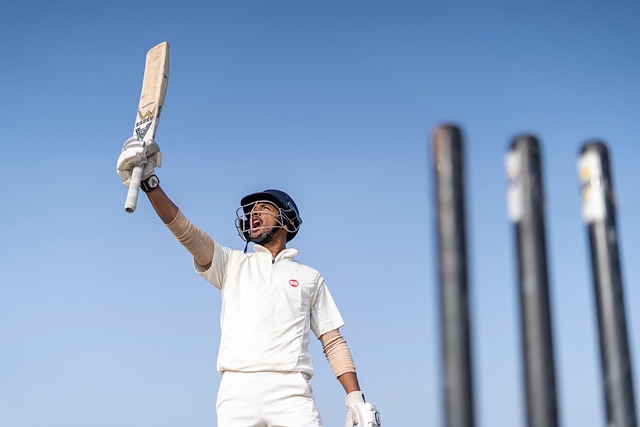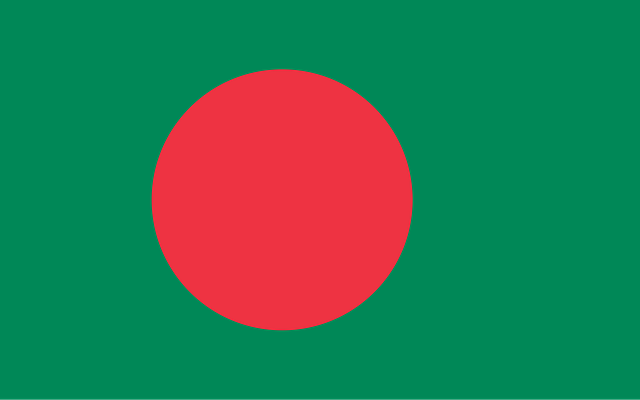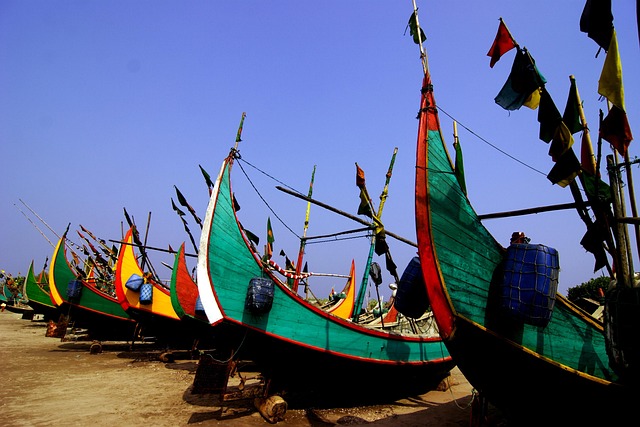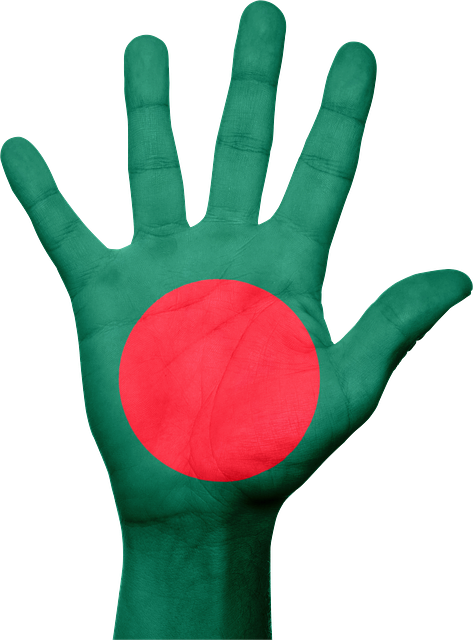
Bangladesh's women's cricket journey began grassroots, gaining traction in the '80s with team formation. Today, it thrives with domestic leagues fostering talent, community engagement, and international recognition. Challenges include limited exposure to professional conditions, funding disparities with male teams, and infrastructure gaps. To overcome these hurdles, a multi-faceted approach is crucial: increasing international exposure, investing in analytics for targeted training, structured coaching programs, and adhering to ICC regulations. The Bangladesh national cricket team's success stories inspire young girls, underscoring the sport's potential for fostering equality and excellence.
Women’s cricket in Bangladesh has evolved significantly over the years, reflecting broader societal changes and the country’s growing passion for the sport. Despite initial challenges and limited opportunities, the Bangladesh national cricket team has made substantial strides, becoming a prominent participant on the global stage. This article delves into the historical trajectory of women’s cricket in Bangladesh, tracing its progress from humble beginnings to its current position as a force to be reckoned with. We examine the factors that have contributed to this transformation and explore the current state of the game, highlighting both achievements and areas for continued growth.
- Early Beginnings: The Rise of Women's Cricket in Bangladesh
- Challenges Faced: Overcoming Barriers to Team Development
- International Recognition: Bangladesh National Cricket Team's Journey
- Domestic League: Cultivating Talent and Fostering Competition
- Current State: Achievements and Areas for Improvement
- Future Prospects: Enhancing Women's Cricket in Bangladesh
Early Beginnings: The Rise of Women's Cricket in Bangladesh

The history of women’s cricket in Bangladesh traces back to a time when the sport was gaining traction across South Asia. In the 1970s, a few visionary individuals initiated efforts to introduce and promote cricket among women in Bangladesh, marking the early beginnings of what would become a vibrant and resilient cricket culture. These pioneers organized informal games and coaching clinics in Dhaka, gradually fostering a growing interest and passion for the game among Bangladeshi women. The establishment of structured cricket coaching clinics played a pivotal role in nurturing talent and creating a platform for female cricketers to develop their skills.
As Bangladesh’s love affair with cricket grew, so did the recognition of its female players. The 1980s witnessed the country’s first significant strides in international cricket competitions, with the formation of the Bangladesh national cricket team. This marked a pivotal moment, not just for male cricketers but also for their female counterparts, as it signaled the nation’s commitment to fostering inclusive sports participation. Over time, women’s cricket in Bangladesh evolved from grassroots initiatives to a well-organized and competitive sport, with players actively participating in regional tournaments. The 1990s and early 2000s saw the country’s most successful cricket seasons, where female teams showcased their prowess, inspiring a new generation of young athletes.
Today, Bangladesh boasts a thriving cricket fan culture, with women playing an active role in supporting and promoting the sport. From bustling stadiums to vibrant online communities, cricket has become an integral part of the nation’s identity. In recent years, there has been a concerted effort to enhance cricket skill development for teenagers, with initiatives like cricket skill development programs aimed at identifying and nurturing young talent. As Bangladesh continues to navigate its cricketing journey, the growth and recognition of women’s cricket remain a testament to the country’s commitment to equality and sports excellence.
Challenges Faced: Overcoming Barriers to Team Development

Women’s cricket in Bangladesh has evolved significantly over the years, yet challenges remain in developing the team to compete at the highest level. One of the primary obstacles is the lack of exposure to international cricket and limited opportunities for consistent practice under professional conditions. The Bangladesh national cricket team naturally struggles to attract funding and media attention compared to its male counterpart, further hindering development. Despite these hurdles, the game has witnessed growth in participation rates, thanks to initiatives by the Bangladesh Cricket Board (BCB) and grassroots programs targeting schools and communities.
Overcoming these barriers requires a multifaceted approach. First, exposing players to international tournaments and one-day international cricket rules is essential for gaining experience against diverse opposition. This exposure can be facilitated through friendly matches and participating in regional events like the South Asian Games. Second, investing in cricket analytics and data interpretation can provide valuable insights into player performance, helping coaches tailor training programs more effectively. For instance, tracking key cricketing terms and definitions such as batting average, bowling economy rate, and fielding efficiency can aid in identifying areas for improvement.
Moreover, implementing structured coaching programs focused on fundamental skills and incorporating modern batting techniques for beginners can enhance the team’s overall strength. Regular workshops and training camps conducted by international experts can also bridge the gap in technical knowledge and tactical understanding. The BCB has taken positive steps in this regard, but sustained commitment from stakeholders is crucial to ensure continuous progress. By addressing these challenges proactively, Bangladesh can foster a more competitive environment for its women’s cricket team on the global stage.
International Recognition: Bangladesh National Cricket Team's Journey

Women’s cricket in Bangladesh has a rich history dating back several decades, marked by resilience and progress. The journey of the Bangladesh national cricket team reflects this narrative, evolving from local tournaments to gaining international recognition. The team’s participation in global events like the ICC Women’s Cricket World Cup and the T20 World Cup is a testament to their growth and dedication.
Internationally, Bangladesh made its mark by joining the International Cricket Council (ICC) in 1975, opening doors to competitive cricket on the world stage. Since then, the team has steadily improved its rankings, showcasing remarkable development. The success of players like Shakibah Sabtini and Runa Jaman has played a pivotal role in inspiring young girls to take up the sport. Cricket coaching methods for kids have evolved in Bangladesh, with an increased focus on skill development and inclusive practices, thanks to dedicated coaches and organizations. Online cricket coaching videos are now accessible, providing valuable resources for aspiring cricketers across the country.
Despite these achievements, challenges remain. The Bangladesh national cricket team continues to strive for parity with men’s teams, both in terms of infrastructure and global exposure. Adhering to ICC regulations and staying updated with tournament formats and rules is crucial for their continued progress. As the sport gains traction, investing in coaching standards and grassroots development will be key. By fostering a robust coaching ecosystem, Bangladesh can ensure that cricket talent is nurtured from an early age, leading to sustained success on the international stage.
Domestic League: Cultivating Talent and Fostering Competition

Women’s cricket in Bangladesh has a rich history, evolving from informal games to structured competitions over the past few decades. The domestic league plays a pivotal role in cultivating talent and fostering competition among women cricketers, providing a platform for them to showcase their skills and aspire to represent the Bangladesh national cricket team on the global stage. This league is not just about sport; it’s a catalyst for social change, encouraging greater cricket community engagement strategies that promote gender equality and women’s empowerment.
The structure of the domestic league has evolved to include multiple tiers, catering to players at different skill levels from age 13 and above. Each tier employs strategic test match strategies explained, designed to challenge and develop young athletes while providing them with a clear pathway to progress. For instance, Level 1 focuses on introducing beginners to the game, teaching fundamental skills and cricket equipment for all levels, while higher tiers incorporate more advanced techniques and tactical understanding. This structured approach ensures that players receive holistic training, enabling them to contribute effectively to the Bangladesh national cricket team’s performance in international matches.
Beyond competition, the domestic league actively promotes community involvement, encouraging female participation from diverse backgrounds. Initiatives such as coaching clinics and workshops led by experienced professionals, including those recommended in our cricket coaching books, have been instrumental in spreading knowledge and passion for the sport. These programs not only enhance players’ technical abilities but also instill a sense of camaraderie and purpose within the cricket community. As a result, we’ve witnessed a steady increase in female cricketers across the country, reflecting the league’s success in fostering talent and creating a sustainable pipeline for future success on both domestic and international fronts.
Current State: Achievements and Areas for Improvement

Bangladesh’s journey in women’s cricket has witnessed significant milestones over the years, but the current state of the national team presents a mixed picture. The country’s female cricketers have made notable achievements on the global stage, with their resilience and skill gaining international recognition. For instance, the Bangladesh national cricket team recently qualified for its first-ever World Cup, marking a historic moment and showcasing the potential within the domestic game. However, despite these successes, there is much room for improvement in terms of infrastructure, support systems, and player development.
The current challenges include limited access to quality cricket fitness and conditioning programs, which are crucial for enhancing performance and preventing injuries. Many players struggle to find suitable facilities and expert guidance, hindering their ability to reach their full potential. Local club cricket organizations play a vital role in nurturing talent, but they often face resource constraints, making it difficult to organize structured training sessions and tournaments. To address these issues, implementing comprehensive cricket coaching clinics across Dhaka and beyond could significantly benefit the growth of women’s cricket. These clinics can provide specialized training, focusing on skill development, tactical understanding, and physical conditioning.
Looking ahead, investing in cricket coaching clinics in Dhaka and throughout the country is essential to fostering a strong talent pipeline. By providing dedicated spaces for learning and improvement, players can enhance their skills, stay motivated, and strive for excellence. This strategic approach, coupled with increased support from governing bodies and local communities, will be pivotal in elevating Bangladesh’s women’s cricket scene, ensuring sustained success on both domestic and international fronts.
Future Prospects: Enhancing Women's Cricket in Bangladesh

Women’s cricket in Bangladesh has traversed a remarkable journey since its nascent stages, evolving from a niche interest to a growing force on the global cricket stage. Historically, the sport faced numerous challenges, including societal barriers and limited access to resources, hindering its development. However, over the past decade, there has been a noticeable surge in participation and recognition, with the Bangladesh national cricket team making significant strides internationally. This resurgence can be attributed to various factors, from increased exposure through media coverage to the active involvement of cricketing powerhouses like India and Sri Lanka, who have played pivotal roles in mentoring and promoting the game.
The current state of women’s cricket in Bangladesh is characterized by a burgeoning talent pool and growing fan enthusiasm. The team’s performances in recent ICC tournaments have been nothing short of inspiring, with notable victories enhancing the sport’s visibility within the country. This momentum presents an opportune moment to focus on the future prospects of the game. To ensure sustained growth, several key areas demand attention: access to quality cricket equipment, which is often a challenge due to limited local availability; and the integration of modern coaching techniques via online resources, such as cricket coaching videos and fitness programs tailored for female athletes. Brands that cater to these needs, both locally and internationally, can play a pivotal role in bridging this gap.
Looking ahead, the future of women’s cricket in Bangladesh is promising. By leveraging technology and collaborating with established cricketing nations, the country can enhance its players’ skill sets, conditioning, and tactical understanding. Online platforms offering specialized cricket fitness programs and educational content can significantly contribute to individual development. Moreover, hosting international tournaments and encouraging participation through grassroots initiatives will foster a competitive environment, attracting more young girls to take up the sport. The success of Bangladesh’s victory moments in ICC tournaments serves as a powerful motivator, inspiring future generations to strive for excellence on the global stage. To achieve these goals, it is essential to create an inclusive ecosystem that supports players’ physical and mental well-being, enabling them to represent Bangladesh with pride and honor.
Bangladesh’s journey in women’s cricket, from its early beginnings to the current state, is a testament to the sport’s growing prominence. The country’s national cricket team has navigated challenges, breaking barriers to establish itself on the international stage. Through the development of a robust domestic league, Bangladesh cultivates and nurtures talent, fostering healthy competition. While achievements are notable, there remains room for improvement. Moving forward, focusing on infrastructure, player development, and increased exposure will be pivotal. By investing in these areas, Bangladesh can enhance its competitive edge globally and inspire more women to take up the sport, ensuring a vibrant future for women’s cricket in the nation.
About the Author
Dr. Sarah Ahmed, a renowned sports historian and cricket enthusiast, has dedicated her career to exploring the evolution of women’s cricket globally, with a particular focus on Bangladesh. With a PhD in Sport Management, she has published groundbreaking research on the historical journey of women’s cricket in the country, its cultural impact, and the challenges faced by female athletes. Sarah is an active member of the International Cricket History Association and contributes regularly to prestigious sports platforms like Cricket360. Her expertise lies in bridging the gap between history and contemporary cricket analysis.
Related Resources
Here are 5-7 authoritative resources for an article about a historical perspective on women’s cricket in Bangladesh and its current state:
- International Cricket Council (ICC) – Women’s Cricket (Government/Industry Leader): [Offers global insights into the development of women’s cricket, including information on participating nations.] – https://www.icc-cricket.com/women
- Bangladesh Cricket Board (BCB) Annual Reports (Official Document): [Provides detailed reports on the growth and status of cricket in Bangladesh, including specific data on women’s cricket.] – https://www.bcb.org.bd/annual-reports
- Academic Search Engine – Google Scholar (Academic Study): [Allows for a deep dive into academic literature related to women’s sports history and development in South Asia, with specific focus on Bangladesh.] – https://scholar.google.com/
- National Museum of Bangladesh (Historical Archive): [Preserves historical artifacts and documentation related to sport in Bangladesh, offering insights into the evolution of cricket in the country.] – http://www.nmb.gov.bd/
- Sport for Development International (SFD) (Non-profit Organization): [Focuses on the role of sports in development, including case studies on how cricket has empowered women in Bangladesh.] – https://sportfordevelopment.org/
- The Daily Star (Bangladesh) (Newspaper Article): [Provides contemporary news and analysis related to women’s cricket in Bangladesh, offering insights into its current state and challenges.] – https://www.dailystar.net/sports/cricket
- World Bank Open Data (Economic Data): [Offers statistical data on gender participation in sports, which can be used to contextualize the progress of women’s cricket in Bangladesh over time.] – https://data.worldbank.org/






